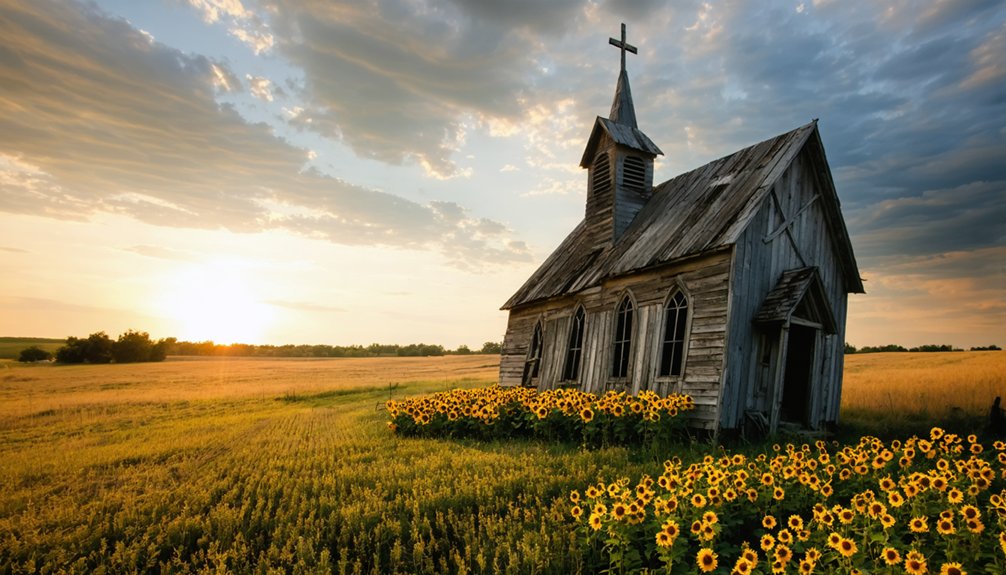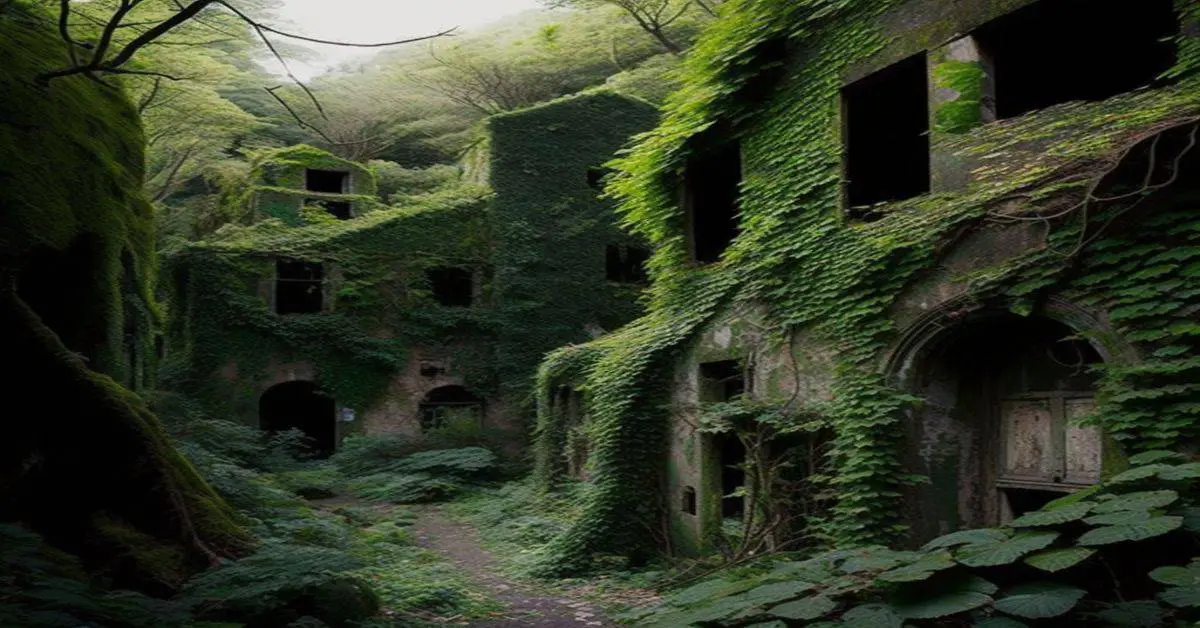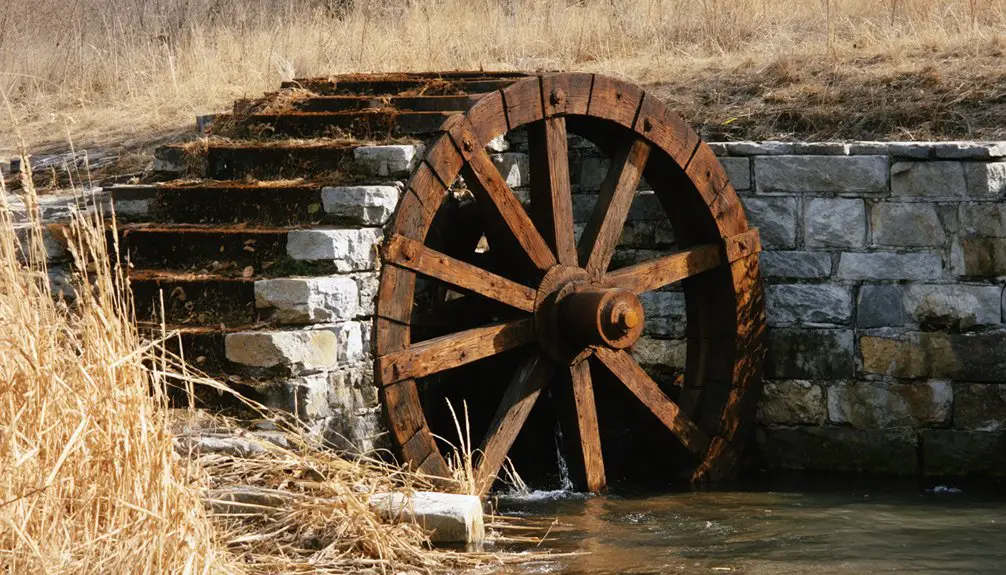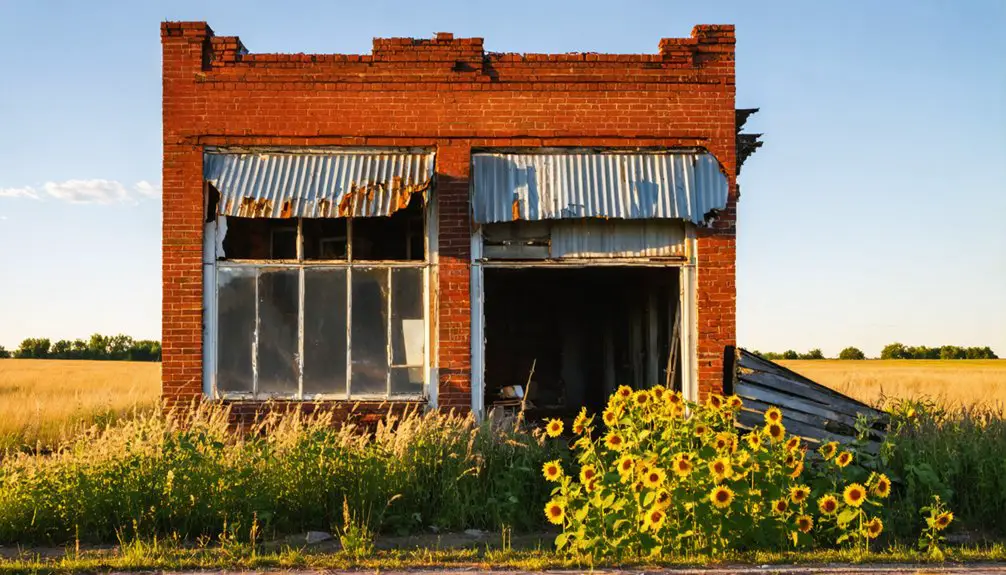You’ll find Ray, Kansas near Hackberry Creek, where it emerged as a prairie settlement in the 1860s alongside the Leavenworth Lawrence Railroad. The town thrived through its grain elevator, general store, and sod church, serving as an essential agricultural shipping point. After the Great Depression hit, Ray’s dependence on farming led to its decline as young residents moved away and services vanished. Today, Ray’s abandoned structures and brick streets tell a fascinating tale of prairie boom and bust.
Key Takeaways
- Ray began as a thriving prairie community in the 1860s, established near Hackberry Creek during westward railroad expansion.
- The town’s growth peaked with the arrival of the Leavenworth Lawrence Railroad in 1868 and Jung and Giessler grain elevator in 1879.
- Economic decline started during the Great Depression, leading to business closures and young residents migrating to larger cities.
- Abandoned buildings, including the church and storefronts along brick streets, now reportedly experience paranormal activity.
- Historical societies preserve Ray’s legacy through artifact collection and educational programs, despite challenges with deteriorating structures.
Origins and Early Settlement Days
Before Ray emerged as a Kansas settlement, the region was home to several Plains Indian tribes, including the Wichita, Pawnee, Kansa, and Osage nations. These tribes had transformed their way of life after acquiring horses from Spanish expeditions, dominating the plains for hunting and trading well into the 18th century.
Native Plains tribes shaped Kansas long before settlers arrived, mastering horsemanship and building thriving communities across the expansive grasslands.
You’ll find that Ray’s story began like many Kansas settlements following the Kansas-Nebraska Act of 1854. Pioneer families chose locations near water sources, essential for survival and farming. Similar to Columbia’s establishment in 1855, settlers faced uncertainty over their land claims until 1857. Like the settlers at Banner who built their homes along Hackberry Creek, early residents strategically positioned themselves near waterways.
The earliest structures typically included log-built general stores and blacksmith shops, serving as gathering places for the sparse population. As in other frontier communities, you’d have seen families sharing living spaces due to limited housing.
The settlement reflected the determination of pioneers to forge new lives on the challenging Kansas frontier, where community bonds formed through shared hardships and mutual support.
The Rise of a Prairie Community
You’ll find Ray’s early community growth directly tied to its strategic location near emerging railroad routes, which helped transport agricultural goods to wider markets.
Similar to Midway’s railroad operations, Ray became an important shipping point that connected local farmers to regional trade networks. The town’s prosperity became evident through its expanding wheat and corn operations, supported by essential services like the local blacksmith shop and general store. The community flourished until the Great Depression brought significant economic hardship and led to business closures.
Community life centered around the church and schoolhouse, where you’d witness Sunday services, box dinner fundraisers, and social gatherings that strengthened the bonds between prairie families.
Early Railroad Connections
Like many Kansas settlements of the late 1860s, Ray emerged during the transformative period of westward railroad expansion.
You’ll find that towns like Ray followed a familiar pattern, springing up alongside the tracks as railroad companies pushed their transportation infrastructure deeper into the prairie.
These settlements served as essential links in the expanding commercial network, connecting previously isolated regions to urban markets and distribution centers.
Just as automobile brands like Sheridan would later emerge to connect Americans to new transportation options in the 1920s, the railroads of Ray’s era revolutionized mobility across the frontier.
The region saw extensive development after the Leavenworth Lawrence Railroad arrived in 1868, bringing new settlers and economic opportunities.
As rail lines transformed the Kansas landscape, they created opportunities for entrepreneurs and settlers who’d establish businesses catering to railroad workers, travelers, and local farmers.
Ray’s strategic position along the tracks meant you could find the typical mix of enterprises that defined railroad towns: mercantile shops, freight operations, and various services supporting the constant flow of people and goods through these new frontier communities.
Agricultural Prosperity Begins
When settlers first arrived in Ray during the late 1870s, they sought fertile land near Hackberry Creek to establish their homesteads, marking the beginning of the community’s agricultural era.
You’d find these pioneers building sod homes and breaking the tough prairie soil, determined to create sustainable farms despite numerous farming challenges.
Similar to the post office, which was established in 1881, the first essential services began to emerge as the town took shape.
As more families arrived, they’d work together to overcome the harsh environment through innovative solutions.
Agricultural innovations emerged through necessity, with farmers sharing resources and labor.
The Jung and Giessler grain elevator became a vital cornerstone of the local farming economy in 1879.
You’d see new creameries and blacksmith shops supporting the growing farm economy, while general stores provided essential equipment and supplies.
The community spirit strengthened through Sunday services, social clubs, and cooperative efforts, transforming Ray from a collection of scattered homesteads into a thriving agricultural center.
Community Gathering Places
Ray’s social fabric wove itself around several key gathering places that transformed the settlement from isolated homesteads into a cohesive community.
The sod church became the heart of social interactions, hosting Sunday services and fundraising events like box dinners that helped purchase essential items for worship. Much like at Bosna schoolhouse, regular box suppers brought neighbors together for fellowship and support. Like many Kansas communities experiencing population decline, Ray’s gathering spaces became increasingly vital for maintaining social connections.
You’d find yourself drawn to these crucial community spaces:
- The general store served as a central hub where you could catch up on local news while picking up supplies.
- The local school hosted literary clubs and cultural gatherings, enriching prairie life beyond basic education.
- Baseball games and annual picnics brought everyone together for recreation and celebration.
These gathering spots helped combat the isolation of prairie life, creating bonds that would sustain the community through challenging times and fostering a shared sense of identity.
Daily Life and Social Fabric
Throughout the early 1900s, the social fabric of Ray was woven through vibrant community gatherings and essential institutions that defined daily life in this Kansas settlement.
You’d find residents gathering for Sunday services in sod churches, participating in literary club meetings, and cheering at local baseball games. Community events often featured fundraising box dinners to support church improvements.
Your daily routines would have centered around farming and ranching, with neighbors sharing labor during busy seasons.
You’d stop by the general store or blacksmith shop, where social interactions naturally blended with commerce. Children played freely in the streets, attended the local school, and joined in annual picnics.
These social connections created a tight-knit community where everyone knew their neighbors and worked together to sustain their prairie town.
Economic Forces Behind Growth and Decline
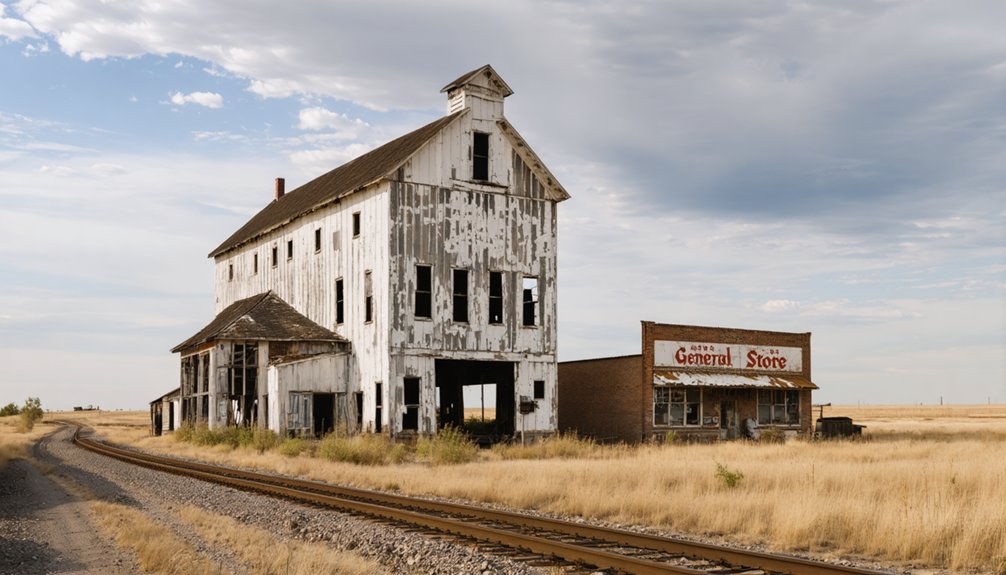
The economic trajectory of Ray mirrored many Kansas settlements that rose and fell with the shifting tides of agricultural markets and technological change.
You’ll find Ray’s story written in the familiar pattern of boom-and-bust cycles that plagued many rural Kansas communities.
Key factors that shaped Ray’s economic destiny:
- Initial growth fueled by railroad connections and productive farmland
- Lack of economic diversification beyond agriculture left the town vulnerable
- Demographic shifts as younger residents sought opportunities in larger cities
The town’s reliance on farming proved unsustainable when agricultural mechanization reduced labor needs.
By the mid-20th century, you’d have witnessed the impact of technological advancement as combines and tractors replaced farmhands, leading to population decline.
Without alternative industries to sustain the community, Ray couldn’t weather the economic pressures that ultimately led to its abandonment.
Notable Buildings and Landmarks
Standing as silent witnesses to Ray’s former liveliness, several notable structures and landmarks provide glimpses into the town’s architectural heritage.
You’ll find architectural features typical of the era, including built-in bookcases, tiled bathtubs, and ornate fireplaces in the remaining residential structures. While exploring these abandoned homes, you might encounter reports of ghostly figures and unexplained phenomena, similar to those documented at other Kansas historic residences.
The town’s commercial district once bustled with activity, marked by brick streets and storefronts that still partially stand today. Railroad infrastructure played a vital role in Ray’s layout, with the main street positioned perpendicular to the tracks.
Brick-lined streets and aging storefronts echo Ray’s vibrant past, where trains once rumbled past its perpendicular main thoroughfare.
The community’s social foundation centered around its church building, which hosted everything from Sunday services to baseball games.
The Path to Abandonment
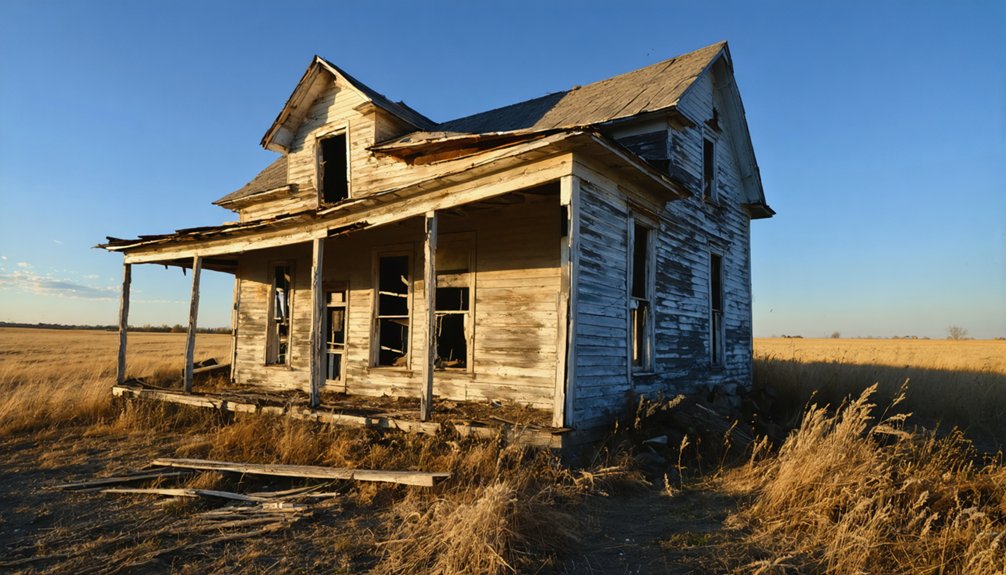
While Ray’s architectural remnants tell stories of its vibrant past, economic forces began dismantling the town’s essence as early as the mid-1900s.
You’ll find a familiar pattern of decline that mirrors many Kansas ghost towns, where transportation evolution and population migration sealed their fate.
- Young residents moved to larger cities for better jobs and education, leaving an aging population without replacement.
- The shift from rail and stagecoach routes diminished the town’s connectivity and commercial viability.
- Loss of essential services like schools, post offices, and local businesses created a downward spiral.
The town’s decline accelerated as infrastructure crumbled and community institutions vanished.
Without resources to maintain public services and with dwindling civic engagement, Ray couldn’t sustain itself.
Natural disasters and changing rural lifestyles dealt the final blows to this once-thriving community.
Preserving Ray’s Historical Legacy
Despite Ray’s physical decline, dedicated efforts to uphold its historical legacy continue through multiple channels of documentation and commemoration.
You’ll find historical societies and local museums actively collecting artifacts, photographs, and oral histories from former residents and their descendants to maintain the town’s memory. Community engagement efforts include public talks and educational programs that share Ray’s story with newer generations.
The preservation challenges are significant – deteriorating structures, limited funding, and access restrictions due to private property ownership complicate conservation work.
However, opportunities exist through grants and partnerships to document remaining physical sites and digitize historical records. These preservation initiatives guarantee that even as Ray’s physical presence fades, its place in Kansas history won’t be forgotten.
Frequently Asked Questions
Are There Any Documented Paranormal Activities or Ghost Stories From Ray?
You’ll find ghost sightings at Ray County Museum, where visitors report unexplained female voices and a woman in white. Beyond the museum’s local legends, there aren’t other well-documented paranormal activities in Ray.
Can Visitors Legally Explore Ray’s Remaining Structures Today?
You’ll need explicit permission since most structures are likely on private property. Current exploration regulations aren’t well-documented, so contact local authorities first to guarantee visitor safety and legal access.
What Natural Disasters, if Any, Contributed to Ray’s Abandonment?
While you might expect dramatic flood damage or drought effects, historical records don’t show any specific natural disasters directly causing Ray’s abandonment. The town’s decline stemmed primarily from economic and transportation changes.
Did Ray Have Any Famous Residents During Its Peak Years?
You won’t find any documented famous residents of historical significance from Ray’s peak years, as records don’t show any notable personalities who called this small Kansas community home.
Are There Any Annual Events or Gatherings Still Held at Ray?
Like a candle extinguished by time’s wind, you won’t find any annual gatherings or community events in Ray today. This ghost town’s silence speaks of abandoned traditions and forgotten celebrations.
References
- https://www.kancoll.org/articles/progress/minneola.htm
- https://hpj.com/2018/07/08/a-130-year-old-general-store-and-memories-keep-kansas-ghost-town-of-banner-alive/
- https://www.legendsofamerica.com/ks-hauntedatchison/
- https://legendsofkansas.com/kansas-ghost-town-list/
- https://www.youtube.com/watch?v=JvCecTIBmFI
- https://dianastaresinicdeane.wordpress.com/2012/01/29/columbia-a-kansas-ghost-town-story/
- https://hpj.com/2018/04/23/the-ghosts-of-kanona-kansas/
- https://www.youtube.com/watch?v=FsVp7y2gTNc
- https://en.wikipedia.org/wiki/History_of_Kansas
- https://legendsofkansas.com/bushong-kansas/
